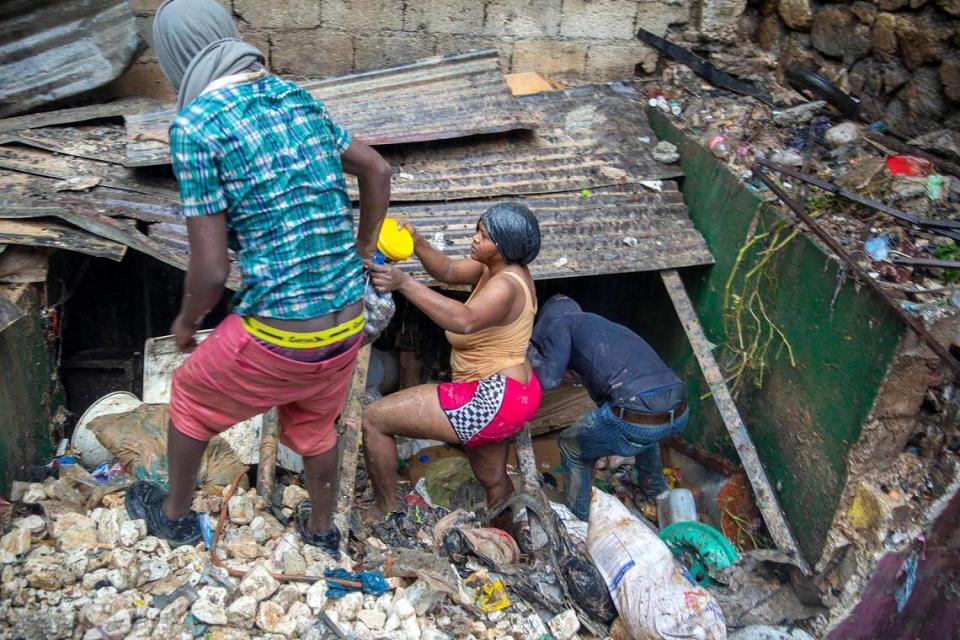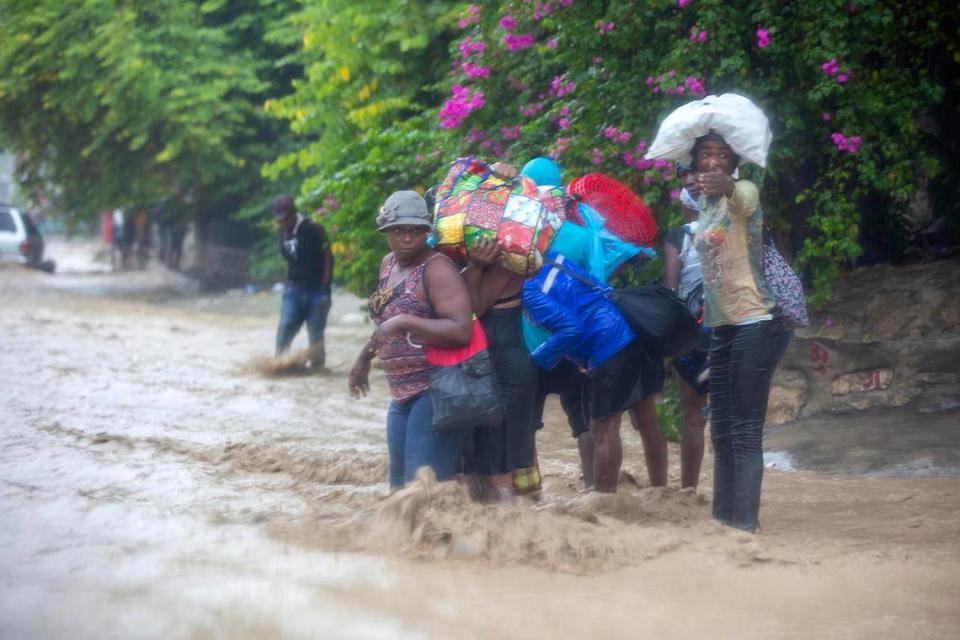Death and destruction in Haiti, Dominican Republic as Tropical Storm Laura batters Caribbean
At least nine people died in Haiti and two were missing on Sunday, when heavy rainfall from Tropical Storm Laura buried large swaths of the country under murky floodwaters and threatened to overpower the country’s only hydroelectric dam.
Four people died in Haiti’s neighbor, the Dominican Republic.
Laura was headed for a possible hit later in the week on the Louisiana coast as a hurricane, along with Hurricane Marco. But first, it was expected to make landfall Sunday evening somewhere between the provinces of Santiago de Cuba and Granma, then move near the southern coast of the island by Monday.
At 8 pm. Sunday, Laura’s center was just 30 miles off Guantanamo.
”The waves are already spilling over the Gibara seawall. Many residents have already left the area for fear of flooding,” Guillermina Montejo, a resident of the coastal Cuban city of Holguín, told el Nuevo Herald.
#TTLaura: Anpil lapli gentan tonbe plizyè kote nan peyi, sitou nan Lwès ak nan Sidès.
Sonje : dlo k ap desann PA JWE️#SezonSiklòn2020 #Laura pic.twitter.com/y5MlBEFWL8— Pwoteksyon sivil (@Pwoteksyonsivil) August 23, 2020
The center of Tropical Storm Laura passed into Haiti Sunday morning after moving from Puerto Rico and through the Dominican Republic, where it also left at least four dead and a destructive trail of floods, heavy rains and wind in its wake.
Among the dead: two, possibly three, children.
In Haiti, a 10-year-old girl in the southeastern town of Anse-à-Pitre near the Haiti-Dominican border was killed when a tree fell on her house. A 10-month-old baby boy was missing after his mother’s Toyota Rav4 car got stuck in the mud in Tabarre and the two appeared to have gotten swept away by flash floods sometime after 7 a.m. Sunday. The lifeless body of the mother, who was identified by a friend as Jessica Jeanniton, a pediatrician, was later found, but not the child.
In the neighboring Dominican Republic, 7-year-old Darwin Frias and his mother, Clarissa, 44, died when their house collapsed in Santo Domingo, the capital, which saw severe flooding and damaged homes.
Video posted on Twitter showed Dominican Civil Defense workers pulling trapped residents out of the rubble in at least one area of Santo Domingo known as Palmarejo.
“We want to show solidarity with the pain of these families; we ask God to bring them comfort and we... will be there to help them with their needs,” Juan Manuel Méndez García, the director of the Center of Emergency Operations, said in a press conference.

Visiting one of the hard-hit neighborhoods, La Yuca, newly sworn-in Dominican President Luis Abinadar promised the crowd he would implement a plan to prevent tragedy around the ravines and rivers in urban areas that are particularly vulnerable to dangerous floods during storms.
“It will take us several years,” Abinader later told one woman who had lost her home. “We will relocate you to somewhere safe and help you with everything. The government is here for you.”
First Lady Raquel Arbaje, visiting an impromptu vigil for the Frias family, said, “You are not alone, we have to make sure no life is lost.”
Laura left more than 1 million Dominicans without power, according to the country’s electric utility, and large parts of the Dominican Republic without water.
Méndez said the storm forced the evacuation of more than 1,050 Dominicans, damaged roads, knocked down trees and downed power lines while leaving large swaths of the country’s 11 million residents without services. Damages, he said, were concentrated in the northern and eastern regions of the country.
While he did not say how many homes had been destroyed, Méndez pointed out that many houses were under the threat of being destroyed “because of what has happened to the rivers.”
In Haiti, Laura’s destruction was equally as severe as roads were cut off, rivers ran over their banks and cars got stuck in mudslides.
Officials spent the better half of an afternoon press conference Sunday pleading with Haitians to not cross rivers, and to protect themselves.
And while they pleaded with Haitians to stay put in some communities, they also begged for some in others “to hurry and flee.”
An overflowing Péligre Dam in Haiti’s Central Plateau meant that authorities had to quickly release its waters, endangering the rice plains and farms in the nearby Artibonite Valley.
“All the radio stations that are here who can call the people of the Artibonite, tell them, ‘Attention!’ Secure their belongings because there is going to be a lot of water in the Artibonite Valley,” Public Works Minister Nader Joaséus said.
The dam is a key supplier of electricity and irrigation for the rice plains and farms north of Port-au-Prince. The probability of its destruction by the storm “was high,” Joaséus said. That would not only create a new crisis for the rural farmers of the Artibonite, who were already struggling with yields as Haiti undergoes a severe food shortage amid the coronavirus pandemic, but “the little bit of electricity, the 10 megawatts that it gives us, we also won’t have it,”Joaséus said.
“If Péligre breaks, it will be catastrophic,” Agriculture Minister Patrick Sévère added, while begging for Haitians cooperate. “We can diminish the effects of flooding but we can’t eliminate it.”

With all of their disaster-prone country under siege by Laura, Haitians experienced flash floods in the southeast, wind gusts of 50 miles per hour in the north and severe flooding throughout, including in the capital, where some were forced to wade through waist-high dirty water.
Even Port-au-Prince’s Toussaint Louverture International Airport was not spared flood waters.
Overnight, Haiti had raised its severe weather alert from orange to red, the country’s highest.
Prime Minister Joseph Jouthe, offering his and the president’s condolences over the loss of life and property, said earlier in the day: “Five people are already dead, and it’s five too many.”
The deaths were mainly in the southeast — where a woman in her 50s was swept away while trying to cross the Gosseline river in the town of Marbial —and in the metropolitan Port-au-Prince area.
“From what I am looking at,” said the mayor of a flooded Cité Soleil slum, Joel Janeus, “it’s not just Cité Soleil that will have a problem if they do not hurry up and do something.“
Janeus said the shantytown, which sits like a basin on the outskirts of Port-au-Prince, was inundated with flood waters.
“It’s not some people who are flooded. It’s the entire area,” he said.
In a 10 a.m. advisory, Haitians were warned not to take Laura lightly.
“Generalized heavy rain accompanied by sustained wind gusts is currently being observed throughout the country,” the advisory said. “Some [regions] of the country including the northeast, Artibonite, center, west and southeast already have 100 percent soil saturation.”
The storm was moving over Haiti with a west-northwest trajectory at about 19 miles per hour. The forecasts called for as much as 12 inches of rain in some parts of the country, particularly in the Nippes, Grand Anse, west and southeast.
Though there were 800 shelters available throughout the country, only a handful had opened to accommodate people in the northeast, southeast and west who had been flooded out of their homes. The government acknowledged that the COVID-19 pandemic made managing shelters difficult and that the coronavirus also had depleted available resources.
With the storm expected to batter Haiti into the evening, Haitians were warned not to let their guard down.
This was also the message in Puerto Rico, even after Laura’s passing. Puerto Rican officials told residents there still remained a high risk of rip currents across the northern coast as the storm moved away from the U.S. territory.
Earlier in the day, Puerto Rico Gov. Wanda Vázquez said there had been no loss of life.
At least 23 storm-related incidents, including six landslides along roads in the municipalities of Comerío, San Germán, Corozal, and Villalba, were reported by the Department of Transportation and Public Works, Vázquez said during a late Sunday morning press conference.
She also mentioned an incident involving two teens, ages 17 and 19, who went to a local swimming hole in Ciales on Saturday, as the storm passed. The teens ended up trapped after the water levels of the river rose and they were forced to spend the night on top of a rock until rescuers retrieved them Sunday morning.
And just as the storm left more than a million Dominicans without power and water, it did the same in Puerto Rico, which suffers from repeated blackouts even without storms.
On Saturday, more than 200,000 customers of the Puerto Rican Electric Power Authority were reported have lost power, though Vázquez said the number had dropped to around 33,000 as of 9 a.m.
But Ángel Figueroa Jaramillo, president of the Electrical Industry and Irrigation Workers Union, tweeted that the number was approximately 50,000 by 11:15 AM.
In addition to the blackout, around 61,000 clients of the Puerto Rico Aqueducts and Sewers Authority did not have water on Sunday morning, said Vázquez, who added that 70% of the water service interruptions were due to the lack of electricity.
At 3 p.m. as life threatening flash floods continued over portions of Haiti and the Dominican Republic, a tropical storm warning remained in effect for the Turks and Caicos Islands and southeastern Bahamas as Laura headed toward eastern Cuba.
A tropical storm watch was also in effect for the Bahamian island of Andros, while other islands in the chain were under alert, according to the Bahamas Department of Meteorology.
By 6 p.m., however, the all clear had been given for several Bahamian islands and the Turks and Caicos Islands. However, a tropical storm warning remained in effect for the islands of Inagua and Ragged Island. Cayman Brac and Little Cayman were also under a tropical storm warning as the center of the Laura was located about 50 miles south of Guantanamo, Cuba.
Jamaica was also feeling the effects of the storm. The National Works Agency said late Sunday that a main road between Gordon Town and Papine in St. Andrew parish was repeatedly blocked due to “continuous heavy rain in the area” that caused mudslides.
“Heavy equipment is in the area, but the situation is extremely dangerous,” the agency tweeted. “Clearing has therefore been suspended until daybreak.”
The center of Laura was expected to move south of the southeast Bahamas on Sunday night and near or over Cuba Sunday evening and Monday.
In Cuba, warnings were also issued.
At 8 pm. the Cuban Institute of Meteorology reported gusts of 90 miles per hour in areas of the north coast of Baracoa.
A tropical storm warning was in effect for all Cuban provinces. The entire country could see heavy rains that could cause floods, landslides, and coastal swells like those left by Laura during her passage through the Greater Antilles.
Earlier Sunday, the National Civil Defense warned that the storm could intensify and issued a “cyclonic alarm” advisory for the eastern provinces and Camagüey, which indicates the imminent passage of a storm. The rest of the central provinces are on alert.
Local authorities were rushing Sunday morning to clean streets, secure buildings, protect crops, and evacuate residents from vulnerable areas, such as the coastal city of Baracoa, in Guantánamo, which is just recovering from the damage caused by Hurricane Isaías in late July. But there were no reports on government media of widespread evacuations.
Montejo, the Holguín resident, remained worried.
”The worst will come later,” she said. “Everyone knows the situation in the country, how difficult it is to get food. If this destroys the few crops that we have, it will be tough for us.”
El Nuevo Herald staff writer Mario J. Pentón contributed to this report.

